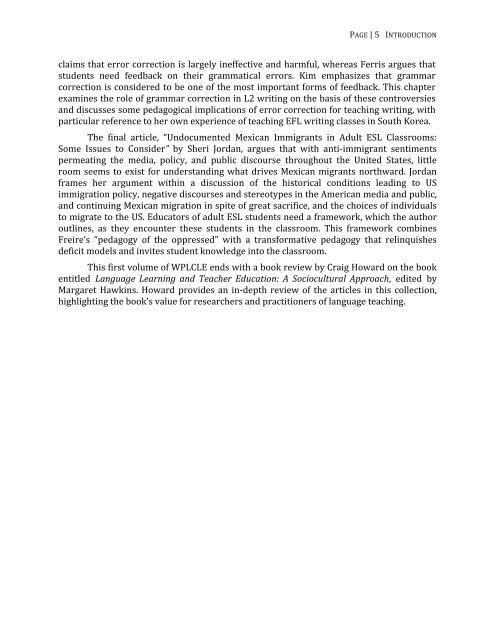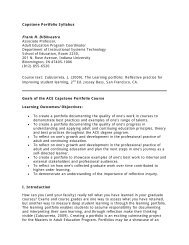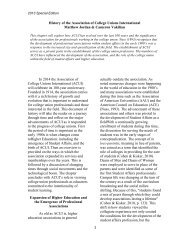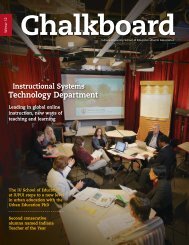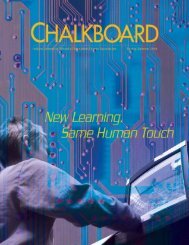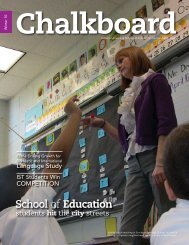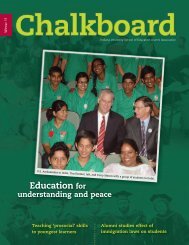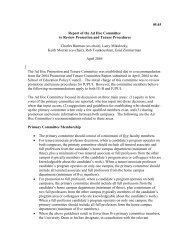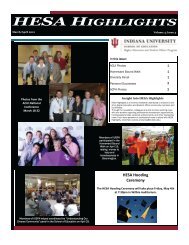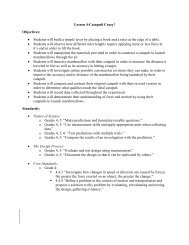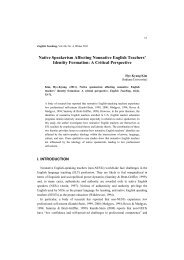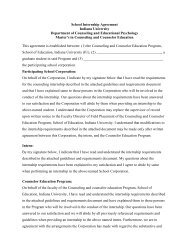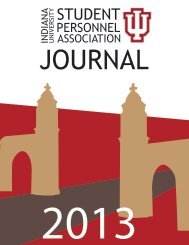- Page 1 and 2: WORKING PAPERS IN LITERACY, CULTURE
- Page 3 and 4: Copyright © 2012 Working Papers in
- Page 5 and 6: TABLE OF CONTENTSContributors .....
- Page 7 and 8: ContributorsDeborah Adeninhun Adeye
- Page 9 and 10: PAGE | viiiCONTRIBUTORSfor non‐na
- Page 11 and 12: INTRODUCTION PAGE | 2Valerie Cross
- Page 13: INTRODUCTION PAGE | 4The ninth essa
- Page 17 and 18: PAGE | 8CROSS & CORONEL‐MOLINAlar
- Page 19 and 20: PAGE | 10 CROSS & CORONEL‐MOLINAp
- Page 21 and 22: PAGE | 12 CROSS & CORONEL‐MOLINAA
- Page 23 and 24: PAGE | 14 CROSS & CORONEL‐MOLINAP
- Page 25 and 26: PAGE | 16 CROSS & CORONEL‐MOLINAm
- Page 27 and 28: PAGE | 18 CROSS & CORONEL‐MOLINAB
- Page 29 and 30: PAGE | 20 CROSS & CORONEL‐MOLINAm
- Page 31 and 32: PAGE | 22 CROSS & CORONEL‐MOLINAg
- Page 33 and 34: PAGE | 24 CROSS & CORONEL‐MOLINAE
- Page 35 and 36: PAGE | 26 CROSS & CORONEL‐MOLINAL
- Page 37 and 38: PAGE | 28MORGANOklahoma pre‐remov
- Page 39 and 40: PAGE | 30MORGAN(HLL) is just starti
- Page 41 and 42: PAGE | 32MORGANinstrumental motivat
- Page 43 and 44: PAGE | 34MORGANKiowa from high scho
- Page 45 and 46: PAGE | 36MORGANchoice and the broad
- Page 47 and 48: PAGE | 38MORGANmotivated. Additiona
- Page 49 and 50: PAGE | 40MORGANand one about langua
- Page 51 and 52: PAGE | 42MORGANValdés, G. (2001).
- Page 53 and 54: PAGE | 44MORGAN80.00%70.00%60.00%50
- Page 55 and 56: PAGE | 46MORGANFIRST CHOICE SECOND
- Page 57 and 58: PAGE | 48MORGANFulfill Last Minor U
- Page 59 and 60: Complexities of Immigrant Identity:
- Page 61 and 62: PAGE | 52ZAKERIchanges would occur,
- Page 63 and 64: PAGE | 54ZAKERImust be understood i
- Page 65 and 66:
PAGE | 56ZAKERIBourdieu (1987) asse
- Page 67 and 68:
PAGE | 58ZAKERIteaching strategies
- Page 69 and 70:
PAGE | 60ZAKERIcapital” and Meyer
- Page 71 and 72:
PAGE | 62ZAKERIWhy should we fight?
- Page 73 and 74:
PAGE | 64ZAKERIprofessors to flouri
- Page 75 and 76:
PAGE | 66ZAKERIFurthermore, in the
- Page 77 and 78:
PAGE | 68ZAKERIPhinney, J. S., & On
- Page 79 and 80:
PAGE | 70 SAMUELSON & KIGAMWApermea
- Page 81 and 82:
PAGE | 72 SAMUELSON & KIGAMWAconstr
- Page 83 and 84:
PAGE | 74 SAMUELSON & KIGAMWAto the
- Page 85 and 86:
PAGE | 76 SAMUELSON & KIGAMWA“Lux
- Page 87 and 88:
PAGE | 78 SAMUELSON & KIGAMWAled th
- Page 89 and 90:
PAGE | 80 SAMUELSON & KIGAMWAAn exa
- Page 91 and 92:
PAGE | 82 SAMUELSON & KIGAMWAIn the
- Page 93 and 94:
PAGE | 84 SAMUELSON & KIGAMWACope,
- Page 95 and 96:
PAGE | 86 SAMUELSON & KIGAMWAAppend
- Page 97 and 98:
The Curriculum as Cultures in Confl
- Page 99 and 100:
PAGE | 90ZHU & CAMICIAIn classrooms
- Page 101 and 102:
PAGE | 92ZHU & CAMICIAimplementatio
- Page 103 and 104:
PAGE | 94ZHU & CAMICIAthe classroom
- Page 105 and 106:
PAGE | 96ZHU & CAMICIAHirsch: You m
- Page 107 and 108:
PAGE | 98ZHU & CAMICIAself and the
- Page 109 and 110:
PAGE | 100ZHU & CAMICIAwho speciali
- Page 111 and 112:
PAGE | 102ZHU & CAMICIABaxter, J. (
- Page 113 and 114:
PAGE | 104ZHU & CAMICIAPanetta, L.
- Page 115 and 116:
LITERACY STUDIES
- Page 117 and 118:
PAGE | 108CHRISTIEillustrations; th
- Page 119 and 120:
PAGE | 110CHRISTIETale (Spiegelman,
- Page 121 and 122:
PAGE | 112CHRISTIEbook goes on to n
- Page 123 and 124:
PAGE | 114CHRISTIEan Iraqi perspect
- Page 125 and 126:
PAGE | 116CHRISTIEthrough the eyes
- Page 127 and 128:
PAGE | 118CHRISTIEFigure 3 Figure 4
- Page 129 and 130:
PAGE | 120CHRISTIEthe ground and ma
- Page 131 and 132:
PAGE | 122CHRISTIEever‐shifting p
- Page 133 and 134:
PAGE | 124CHRISTIEHeffernan, L., &
- Page 135 and 136:
PAGE | 126COLOMBOMethodIn this pape
- Page 137 and 138:
PAGE | 128COLOMBOFormcoercion hegem
- Page 139 and 140:
PAGE | 130COLOMBOFor example, Canag
- Page 141 and 142:
PAGE | 132COLOMBOof language is not
- Page 143 and 144:
PAGE | 134COLOMBOover the national
- Page 145 and 146:
PAGE | 136COLOMBOmeans that allows
- Page 147 and 148:
PAGE | 138COLOMBOuniversal. This fi
- Page 149 and 150:
PAGE | 140COLOMBOMartín‐Martín,
- Page 151 and 152:
PAGE | 142 MACHARASCHWILI & COGGINT
- Page 153 and 154:
PAGE | 144 MACHARASCHWILI & COGGINt
- Page 155 and 156:
PAGE | 146 MACHARASCHWILI & COGGINS
- Page 157 and 158:
PAGE | 148 MACHARASCHWILI & COGGINc
- Page 159 and 160:
PAGE | 150 MACHARASCHWILI & COGGINt
- Page 161 and 162:
PAGE | 152 MACHARASCHWILI & COGGINT
- Page 163 and 164:
PAGE | 154 MACHARASCHWILI & COGGINd
- Page 165 and 166:
PAGE | 156 MACHARASCHWILI & COGGINw
- Page 167 and 168:
PAGE | 158 MACHARASCHWILI & COGGINR
- Page 169 and 170:
PAGE | 160 MACHARASCHWILI & COGGIN5
- Page 171 and 172:
PAGE | 162BOSEAlso, a separate segm
- Page 173 and 174:
PAGE | 164BOSENumber of Bilingual/B
- Page 175 and 176:
PAGE | 166BOSEdescribed that in a b
- Page 177 and 178:
PAGE | 168BOSEMichigan, Polish and
- Page 179 and 180:
PAGE | 170BOSEbelow). The number of
- Page 181 and 182:
PAGE | 172BOSEPercentage of College
- Page 183 and 184:
PAGE | 174BOSEapplied for and recei
- Page 185 and 186:
PAGE | 176BOSEdifferent ethnic grou
- Page 187 and 188:
PAGE | 178BOSEgenealogy is a preval
- Page 189 and 190:
PAGE | 180BOSEThe article recommend
- Page 191 and 192:
PAGE | 182BOSEKachru, B. B. (1996).
- Page 193 and 194:
Literacy Programs for Incarcerated
- Page 195 and 196:
PAGE | 186BRACE(2001) use this pers
- Page 197 and 198:
PAGE | 188BRACEThere is also an ove
- Page 199 and 200:
PAGE | 190BRACEOn a broader structu
- Page 201 and 202:
PAGE | 192BRACEIssues in Research M
- Page 203 and 204:
PAGE | 194BRACEstructural problems
- Page 205 and 206:
PAGE | 196BRACEspirit” (Freire, 2
- Page 207 and 208:
ENGLISH AS A SECOND AND FOREIGNLANG
- Page 209 and 210:
PAGE | 200SUHcontexts in terms of s
- Page 211 and 212:
PAGE | 202SUHdivided into groups, a
- Page 213 and 214:
PAGE | 204SUHSecond, the teacher pr
- Page 215 and 216:
PAGE | 206SUHA Lesson Plan: Oprah W
- Page 217 and 218:
PAGE | 208SUH4) Expansion: Homework
- Page 219 and 220:
PAGE | 210SUHChamot, A., & Robbins,
- Page 221 and 222:
PAGE | 212SUHAppendix B. Inquiry Ch
- Page 223 and 224:
PAGE | 214ADEYEMIBackground to the
- Page 225 and 226:
PAGE | 216ADEYEMIRationale for Teac
- Page 227 and 228:
PAGE | 218ADEYEMIThe study was done
- Page 229 and 230:
PAGE | 220ADEYEMIIt is important fo
- Page 231 and 232:
PAGE | 222ADEYEMIlanguage (Adeyemi,
- Page 233 and 234:
PAGE | 224ADEYEMIThese views to lit
- Page 235 and 236:
PAGE | 226ADEYEMIRepublic of Botswa
- Page 237 and 238:
PAGE | 228KIMIn this paper, I will
- Page 239 and 240:
PAGE | 230KIMdrawing their attentio
- Page 241 and 242:
PAGE | 232KIMreading in class or ho
- Page 243 and 244:
PAGE | 234KIMteachers can help stud
- Page 245 and 246:
PAGE | 236KIMFerris, D. R., & Hedgc
- Page 247 and 248:
Undocumented Mexican Immigrants in
- Page 249 and 250:
PAGE | 240 JORDANration was seen as
- Page 251 and 252:
PAGE | 242 JORDANdevelopment, my st
- Page 253 and 254:
PAGE | 244 JORDANcaught. What they
- Page 255 and 256:
PAGE | 246 JORDANPart of empowering
- Page 257 and 258:
PAGE | 248 JORDAN“border crossers
- Page 259 and 260:
PAGE | 250 JORDANPerlmutter, P. (19
- Page 261 and 262:
PAGE | 252HOWARDcases where multimo
- Page 263:
PAGE | 254HOWARDReferencesCanale, M


